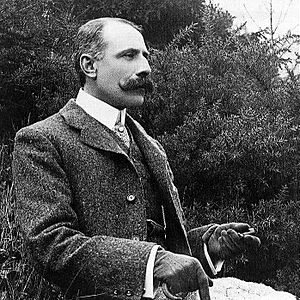Anthony Payne facts for kids
Quick facts for kids
Anthony Payne
|
|
|---|---|
 |
|
| Born |
Anthony Edward Payne
2 August 1936 London, UK
|
| Died | 30 April 2021 (aged 84) Islington, Greater London, UK
|
| Occupation |
|
|
Notable work
|
List of compositions |
| Spouse(s) | Jane Manning |
Anthony Edward Payne (born August 2, 1936 – died April 30, 2021) was an English composer. He was also a music critic and a musicologist, someone who studies music history.
Payne is most famous for finishing Edward Elgar's third symphony. Elgar was a famous composer who died before he could finish it. Payne's version was very well-received. He was also known for his chamber music, which is music for a small group of instruments. Many of these pieces were written for his wife, the singer Jane Manning. They also had a music group called Jane's Minstrels.
At first, Payne wrote very modern music. But by the 1980s, his music started to mix modern sounds with the older, romantic style of English composers like Elgar.
Contents
About Anthony Payne
Early Life and Learning (1936–1964)
Anthony Edward Payne was born in London on August 2, 1936. His father worked for the government. Anthony didn't come from a very musical family.
When he was 10, he heard Brahms's First Symphony on the radio. He said it "absolutely translated" him and he was "hooked like a fish." The next year, he got a recording of Tchaikovsky's First Piano Concerto. This made him even more interested in music. He started composing when he was about 11 years old.
From 1947 to 1955, Payne went to Dulwich College. He mainly studied old languages there. But he still found time for music. He wrote an orchestral suite and a piano sonata. He also played the clarinet regularly. He loved music by Mozart and Haydn. But his biggest inspirations were English romantic composers like Elgar, Delius, and Vaughan Williams.
After college, Payne took a break from composing for four years. During this time, he worked as a freelance music critic. In 1964, he started composing again. He began to find his own unique style.
Becoming a Composer (1965–1980)
Payne's new style was first heard in his Phoenix Mass. He started this piece in 1965 and finished it in 1969. The title "Phoenix" means a new beginning. It showed his renewed passion for composing. This piece used specific musical intervals (distances between notes) for different parts. Payne said it was his first major work.
In 1966, Payne married the soprano (high-voiced singer) Jane Manning. His next work, Paraphrases and Cadenzas (1969), used similar musical ideas. He later updated both of these pieces.
Payne also explored using numerology in his music. This means using numbers to decide how the music is put together. His piano piece Paean (1971) is an example of this. In 1970, Payne and Manning moved to Islington, London. They lived there for the rest of their lives.
He wrote many pieces for choirs and singers. These often used poems by British writers. One important piece was Concerto for Orchestra (1974). It was his biggest work at the time. He also wrote First Sight of Her and After (1975) for 16 solo voices. This piece won an award.
Mixing Styles (1981–1992)
In 1981, Payne wrote A Day in the Life of a Mayfly. This piece was important because it was the first time he openly mixed his modern style with the older English Romantic music he loved. A colleague called this "modernized nostalgia." This piece became his most famous work at the time.
He continued to write many different types of music. These included pieces for solo instruments, choirs, orchestras, and brass bands. In the 1980s, he also taught music at several universities. These included Mills College in California and the London College of Music.
In 1988, he started a new music group with his wife, Jane Manning. It was called Jane's Minstrels. Many of his pieces were written for this group. They also performed music by other famous composers.
His orchestral work, Time's Arrow (1990), was a big success. It was inspired by the idea of the Big Bang. It starts very quietly and builds up with powerful brass and percussion sounds.
Finishing Elgar's Symphony (1993–1997)
One of Anthony Payne's most famous achievements was completing Edward Elgar's unfinished Third Symphony. Elgar died in 1934, leaving behind many musical sketches for this symphony. He had mixed feelings about someone else finishing his work. But he also said, "If I can't complete the Third Symphony, somebody will complete it."
The Elgar family eventually decided to let Payne work on the symphony. They knew the sketches would soon be available to the public. Payne had been studying Elgar's sketches since 1972. He started working on the completion in 1993. Elgar's notes were very messy and hard to read.
Payne's finished version was called Edward Elgar: the sketches for Symphony No 3 elaborated by Anthony Payne. It was first performed in February 1998 in London. The BBC Symphony Orchestra played it, conducted by Sir Andrew Davis.
The piece was an instant hit! It was performed over 150 times in just four years. It has been recorded many times and is now widely accepted as part of Elgar's works. In 1998, Payne wrote a book about how he completed the symphony.
While working on the symphony, Payne also wrote other pieces. He taught at the University of Western Australia in 1996.
Later Years and Passing (1998–2021)

After the huge success of the Elgar symphony, Payne found it hard to compose his own music again. He felt like he had been "playing Elgar" for so long. He worried he wouldn't be able to write "his own stuff."
He wrote a few smaller piano pieces. But his return to large-scale works came with Visions and Journeys (2002). This orchestral piece was inspired by the Isles of Scilly and was very well-received.
Payne also completed another of Elgar's unfinished pieces, Pomp and Circumstance March No. 6. It was first performed on his 70th birthday in 2006. From 2012 to 2013, he was a professor at the University of East Anglia. His String Quartet No. 2 won an award in 2011.
His last major work was Of Land, Sea and Sky (2016). It was written around his 80th birthday. This piece was inspired by sounds like horses' hooves and the beauty of landscapes.
Anthony Payne passed away on April 30, 2021, at the age of 84. He died about a month after his wife, Jane Manning. His friends noted that they were always together.
Payne's Music Style
How His Music Sounds
Anthony Payne was influenced by many composers. But the English Romantic composers like Elgar, Delius, and Vaughan Williams had the biggest impact. He even called Vaughan Williams a "musical godfather."
In the mid-1960s, Payne started using more modern ideas in his music. For example, in his Phoenix Mass, each section focuses on a specific musical interval. An interval is the distance between two notes.
He was also interested in numerology. This is using numbers to create musical patterns. His piano piece Paean (1971) uses a series of numbers to build its structure. Another piece, The Stones and Lonely Places Sing (1979), uses numbers to decide how long musical phrases are. His music often featured wide-spaced harmonies and changes between strict and free rhythms.
Payne wrote music for many different types of groups. He wrote for orchestras, brass bands, and solo instruments. But he was mainly known for his chamber music. This is music for a small group of instruments. Many of these pieces were written for his wife's group, Jane's Minstrels.
Even though he received regular requests for new music, he didn't earn a lot from composing. He had to work as a music critic and musicologist to make enough money. He once said, "Still, you do it for love, don’t you?"
His Place in Music History
Anthony Payne was not always a super famous composer. This might be because his music mixed older English Romantic styles with modern sounds. He once said he was surprised to win an award because he was "one of those composers who never win awards."
However, he made important contributions to music. His orchestral works like Time's Arrow (1990) and Visions and Journeys (2002) were highly praised. He also wrote many song cycles (groups of songs).
Before he completed Elgar's symphony, he was best known for his chamber work A Day in the Life of a Mayfly. But his work on Elgar's Third Symphony is what he is most remembered for.
In August 2021, the BBC Symphony Orchestra played one of Payne's pieces as a tribute to him.
Selected Publications
Besides composing, Anthony Payne was also a respected writer about music. He wrote books about composers like Arnold Schoenberg and Frank Bridge. He was also a well-known music critic. He wrote for major newspapers like The Daily Telegraph and The Independent. He also wrote for Country Life magazine.
Awards and Honours
- Radcliffe Award, 1975, for First Sight of Her and After
- Listeners' award in the first Radio 3 British Composer Awards, 2003, for Visions and Journeys
- Honorary Doctor of Music (with his wife Jane Manning), University of Durham, 2007
- British Composer Awards Winners: Chamber category, 2011, for String Quartet No. 2
- Elgar Medal from the Elgar Society, 2011
- Honorary Doctor of Music from Kingston University
- Honorary Doctor of Music from University of Birmingham
- Fellow of the Royal College of Music
Images for kids




